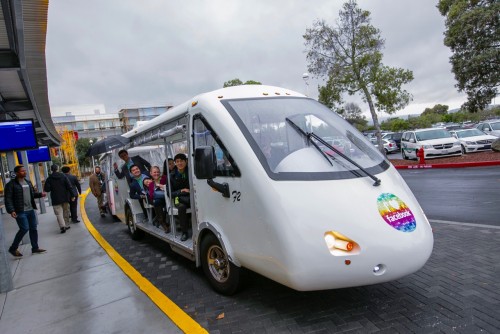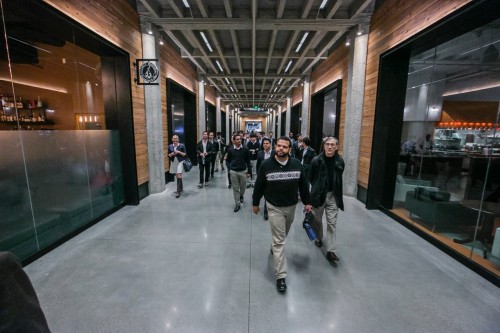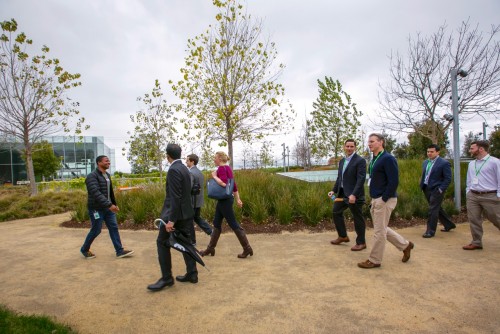
 First year students in the Baker Program of Real Estate gained first-hand exposure to the influence that technology companies have within the real estate sector on their inaugural domestic trip to San Francisco. As described in Part One, this second installment of the Baker San Francisco Trek series shows how San Francisco has been a booming commercial real estate center over the past decade. With a rapidly-changing skyline representative of the electronic age, students had the opportunity to see how technology, and the companies in the Bay Area have, and will continue to influence commercial office space moving forward.
First year students in the Baker Program of Real Estate gained first-hand exposure to the influence that technology companies have within the real estate sector on their inaugural domestic trip to San Francisco. As described in Part One, this second installment of the Baker San Francisco Trek series shows how San Francisco has been a booming commercial real estate center over the past decade. With a rapidly-changing skyline representative of the electronic age, students had the opportunity to see how technology, and the companies in the Bay Area have, and will continue to influence commercial office space moving forward.
With the highest floor plate in San Francisco on the 52nd floor at 555 California St., students met with Meade Boutwell of CBRE to gain an exclusive tour of Finnish gaming company Supercell’s office. Although known for fun smart phone games such as Clash of Clans and Boom Beach, Supercell resides in a design-forward workspace. Their current space was originally a private club and restaurant, and the whole building was leased to financial firms like Bank of America. Now the space is leased to the gaming company, with only 25 employees. It took a lot of convincing for Vornado to agree to lease to a technology company they had never heard of, but once they saw the revenue stream coming into the company from Apple Store sales, they realized that this company had legitimate long-term viability.
“Another thing that turned my mind around completely is Supercell, a company that makes smartphone games like Hay Day occupies the most prime real estate spaces in San Francisco. And their office space was huge! Every working station was the size of any significant Wall Street investment banker.” -First year student Adrian Martinez of Monterrey, Mexico
 This initial space provided the tone that the future of workspace represents cooperation and limited hierarchy. Per the first installment, the students were greeted, instructed, and toured by Ben Tranel of Gensler the next morning. During the informative discussion, Ben detailed that the majority of construction completed for technology companies occurs through speculation. However, the workspaces must provide hyper-collaborative and shared space, increasing the human density per floor plan and also the building performance efficiency. These themes are believed to be the future of workspaces moving forward, and the Bay Area is one of the key incubators building and leasing this type of space.
This initial space provided the tone that the future of workspace represents cooperation and limited hierarchy. Per the first installment, the students were greeted, instructed, and toured by Ben Tranel of Gensler the next morning. During the informative discussion, Ben detailed that the majority of construction completed for technology companies occurs through speculation. However, the workspaces must provide hyper-collaborative and shared space, increasing the human density per floor plan and also the building performance efficiency. These themes are believed to be the future of workspaces moving forward, and the Bay Area is one of the key incubators building and leasing this type of space.
Upon arriving at the campus of Facebook in Menlo Park, CA (former home to technology forerunner Sun MicroSystems), students confirmed the theories of the changing workspace based on technology companies.
“I realized how great, successful technology companies value creativity within commercial real estate. Here, money is not an issue; the issue is that all of the technology companies want to have their own uniquely-designed spaces. All of these companies aim to create a comfortable space for their employees to boost the productivity…. The new office building of Facebook, which is designed by Frank Gehry known for his creative and costly designs, shows again how important it is for tech companies to create a comfortable work environment.” -First year student Amin Elahy of Dubai, United Arab Emirates
 The amenity menu available to employees resembles that of an ultra-luxury multifamily asset. Facebook tries to have everything on site that will keep their workers motivated. This includes many restaurants, a bike shop, and dessert bar. Upon reaching Hacker Square, located at the center of the original campus where a proud pirate flag flies to designate the counter culture, the students were educated on the idea of hacking.
The amenity menu available to employees resembles that of an ultra-luxury multifamily asset. Facebook tries to have everything on site that will keep their workers motivated. This includes many restaurants, a bike shop, and dessert bar. Upon reaching Hacker Square, located at the center of the original campus where a proud pirate flag flies to designate the counter culture, the students were educated on the idea of hacking.
Facebook believes hacking involves building something new. On predetermined nights, employees will collaborate to invent and innovate during their self-hosted Hack-A-Thon events. The night is not complete until a new idea or product has been formed. Moving on from Hacker Square, the tour then commenced to the new Frank Gehry building. The space resembles a factory, and was designed and built as one big room. The amenity list grew when the students viewed the vending machines with computer parts, continuing the motif of doing all that is necessary to keep employees supplied with everything they need.
Next, the group visited with Related Companies to learn about their development projects in California: Baker Program San Francisco Trek: Part 3
